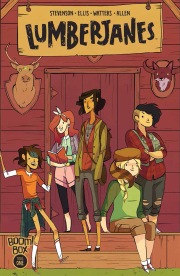
I read books because I love reading. I also read because I research literacy and literature. I recently had to admit I have a bias, grounded in lie experience, and because of this bias I have made a study of the authors of the graphic novels with women and girl protagonists. I hate to say it, but I really thought I was going to call guys out on the ways women and girls are over-sexualized objects. I was saving up a big rant about MEN and WOMEN and ALL THE THINGS. But, I can’t. I have to listen to the data and the data says it is more complicated than simply men and women, because sometimes guys get it right, too.


First, a woman who writes terrific girls and women. Noelle Stevenson has successfully written two of my favorite graphic novels, Nimona and LumberJanes. There is something about the giddy, no holds barred, ridiculous nature of her books that keeps me coming back to read and reread. Whats more, is these books feature women and girls as flawed, interesting, complex protagonists that learn and grow.
Lumberjanes, features a group of friends at summer camp who stumble, fall, leap, and crash into adventures. This is NOT a “girl book” where boys will be lost or uninterested. The goofy-adventurer spirit will attract both boys and girls. My ten year old son and I keep stealing the book from each other.
Nimona is different, but still has a lightness to the story. Stevenson’s overly exaggerated style fits the story of a young girl (who happens to be a shape shifter) joining forces with Lord Blackheart (the evil villain) to over through the government — or something like that. But, it is also a story of friendship and redemption.
Oh! And both books have gay characters that don’t suffer or die or live awful, lonely lives because of their sexual identity.
And then there is Barry Deutsch. Remember when I mentioned that I kept thinking that the problem with over-sexualized girls in graphic novels was male authors? Well, I was wrong. It isn’t that easy to point fingers at any one group or the other.
The Hereville series is … wonderfully odd. It features an 11 year old girl, Mirka, who is smart, seeks adventure and is an orthodox jew. She lives in a modern day orthodox community with her father, her brother, her sisters, her step-mother, and the memory of her mother. Mirka isn’t interested in learning how to be a good wife and mother. Instead, Mirka wants to slay dragons, fight witches, battle trolls, and save her sister from an evil fish who grants wishes.
Deutsch, much like Stevenson, uses a cartoonish style with lots of color and motion. The characters are sometimes dramatically overstylized with huge noses, crazy hair, and enormous fins. Mirka is a pain in the butt to her stepmother, sometimes she’s not a great sister, and most of the time she is simply not listening. The orthodox family life is shown with respect and love. Deutsch provides the reader with yiddish expressions that flow from Mirka and her family with ease.
Both of these authors have created characters and worlds that draw readers in, invite us to ride along in the adventure, and leave feeling that the world is a little goofy, but definitely, a better place.



I adore Stevenson’s graphic novels – very raw, refreshingly-candid, and just so real. I have a copy of the first Hereville in my bookshelves waiting to be read, but I don’t think I have the rest of the books in the series – that’s something I should definitely look out for.
“I hate to say it, but I really thought I was going to call guys out on the ways women and girls are over-sexualized objects. I was saving up a big rant about MEN and WOMEN and ALL THE THINGS. But, I can’t. I have to listen to the data and the data says it is more complicated than simply men and women, because sometimes guys get it right, too.”
Can we talk about this soon? At AERA, perhaps? I collected data for my dissertation on this topic and learned some surprising things about how my study participants defined gender in comics, and what they were looking for (gender-wise) in a graphic text.